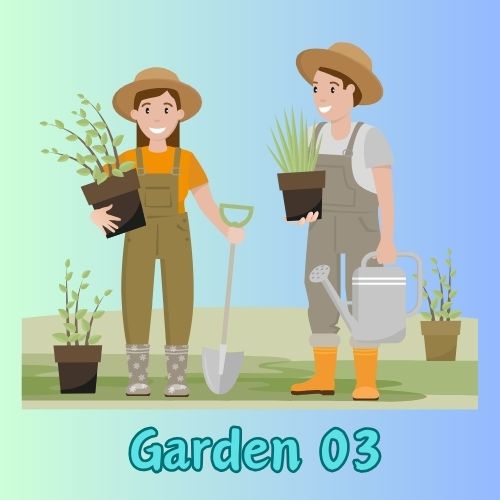Cilantro, also known as Coriandrum sativum, is a versatile herb commonly used in a variety of cuisines around the world. Whether you’re making salsa, curries, or garnishing soups, cilantro’s bright, fresh flavor can enhance your dishes. Learning how to grow cilantro seeds can be an incredibly rewarding experience, especially if you’re a home gardener looking to cultivate your own herbs.
In this comprehensive guide, Garden 03 wIll walk you through everything you need to know about growing cilantro from seeds, from choosing the right seeds and preparing the soil, to planting, caring for, and harvesting this flavorful herb. By the end of this article, you’ll be able to grow cilantro seeds with confidence, ensuring a bountiful harvest season after season.
Benefits of Growing Cilantro at Home
Before diving into the steps of how to grow cilantro seeds, let’s take a look at the key benefits of growing cilantro in your home garden:
1. Freshness and Flavor
Store-bought cilantro often loses its potency quickly. Growing cilantro at home allows you to enjoy the freshest leaves possible, delivering the best flavor to your kitchen.
2. Cost Efficiency
Buying fresh herbs regularly can be expensive. Growing cilantro from seeds is a cost-effective way to have a continuous supply of this herb.
3. Herbal and Medicinal Uses
Beyond its culinary uses, cilantro also has health benefits. It’s rich in antioxidants and can support detoxification processes in the body.
4. Encouraging Pollination
Cilantro flowers attract beneficial insects, including bees and butterflies, helping to pollinate your garden and promote the health of other plants.
Understanding Cilantro Seeds
Cilantro is a plant with two purposes: the fresh leaves are called cilantro, while the seeds produced are known as coriander. In many recipes, cilantro refers to the fresh herb, and coriander to the seeds. When growing cilantro, you’ll first plant the seeds, which eventually turn into both the herb and the coriander seeds.
1. Cilantro vs. Coriander
It’s important to distinguish that while cilantro and coriander come from the same plant, they are used differently. Cilantro seeds are planted to produce the leafy herb, but those same seeds, when matured, become coriander (the spice).
2. Cilantro Seed Varieties
There are a few different varieties of cilantro seeds available, including:
- Santo Cilantro: Known for its slow bolting tendency, making it ideal for warmer climates.
- Calypso Cilantro: A hardy variety that offers abundant harvests.
- Leisure Cilantro: A traditional variety that’s popular among gardeners for its classic flavor and steady growth.
When choosing seeds, opt for certified organic varieties if possible to ensure the best results.
How to Grow Cilantro Seeds: Step-by-Step Guide

1. Choosing the Right Location
Cilantro thrives in areas that offer both sunlight and some protection from intense heat. While cilantro loves the sun, too much heat can cause it to bolt prematurely.
Key Considerations for Cilantro’s Growing Environment:
- Sunlight: Cilantro prefers full sun to partial shade. In warmer climates, it’s best to provide cilantro with some afternoon shade to prevent bolting.
- Temperature: The optimal growing temperature for cilantro is between 50°F and 85°F (10°C to 29°C). Temperatures beyond this range may cause the plant to go to seed quickly.
If you live in a particularly hot region, consider growing cilantro in containers so that you can move it into the shade during the hottest part of the day.
2. Preparing the Soil for Cilantro
Soil preparation is a critical factor when learning how to grow cilantro seeds. Cilantro prefers well-drained soil that’s rich in organic matter.
Ideal Soil Conditions:
- Soil Type: Cilantro grows best in light, well-draining soil that is slightly sandy or loamy.
- pH Levels: The ideal pH for cilantro ranges from 6.2 to 6.8, which is mildly acidic to neutral.
- Soil Enrichment: Before planting, mix in compost or well-rotted manure to improve soil fertility. This will give cilantro seeds the nutrients they need for a healthy start.
3. Planting Cilantro Seeds
The key to a successful cilantro crop is properly sowing the seeds. Here’s how to plant cilantro seeds:
Step-by-Step Instructions:
- Step 1: Seed Preparation
- You can plant cilantro seeds directly in the ground without any preparation. However, if you want to speed up germination, gently crush the seed husk with your fingers or soak them in water for 12-24 hours before planting.
- Step 2: Sow the Seeds
- Plant cilantro seeds about 1/4 inch deep in rows or clusters. Space the seeds approximately 6-8 inches apart to give the plants room to grow.
- Water the soil immediately after sowing to keep it moist, but avoid waterlogging.
- Step 3: Spacing and Thinning
- Once the seedlings are a few inches tall, thin them out to allow about 8-12 inches between each plant. This gives them enough space to grow without competing for nutrients.
Seed Germination:
Cilantro seeds generally take about 7-21 days to germinate. The germination rate can depend on temperature, soil conditions, and seed quality.
4. Caring for Cilantro Plants
Cilantro is relatively low-maintenance, but it does need some care to grow well. Here are key care tips:
Watering
Cilantro prefers consistently moist soil but doesn’t like to sit in water. Water the plants regularly to maintain soil moisture, especially during dry periods. However, ensure that the soil is well-drained to prevent root rot.
- Tip: Use mulch around the plants to help retain moisture and suppress weeds.
Fertilizing
Cilantro isn’t a heavy feeder, but applying a balanced organic fertilizer or compost every few weeks can boost its growth. Avoid excessive nitrogen-rich fertilizers, as they can cause the plant to focus more on leaf production rather than seed development.
Weeding
Keep the area around the cilantro plants free of weeds, as weeds compete for water and nutrients. Regular weeding or mulching can prevent this.
Temperature Management
Cilantro is sensitive to heat. When temperatures rise, the plant may bolt, which means it will quickly produce flowers and seeds instead of leaves. To prevent this, you can:
- Plant in cooler seasons (spring and fall).
- Provide partial shade during hot afternoons.
5. Pest and Disease Control
Cilantro is relatively resistant to pests and diseases but can still face issues with aphids, spider mites, and fungal diseases.
1. Common Pests:
- Aphids: These small, sap-sucking insects can be managed by spraying the plants with a mixture of water and mild soap or by introducing beneficial insects like ladybugs.
- Spider Mites: These tiny pests can be deterred by keeping the plants well-watered, as spider mites thrive in dry conditions.
2. Fungal Diseases:
- Powdery Mildew: Cilantro can occasionally develop powdery mildew, a fungal disease that covers the leaves in a white, powdery substance. Avoid overhead watering, and ensure good air circulation to prevent this.
6. Harvesting Cilantro
Knowing how to grow cilantro seeds is only part of the process; harvesting is equally important to ensure a steady supply of fresh herbs.
Harvesting Cilantro Leaves:
- When to Harvest: You can start harvesting cilantro leaves once the plants are 6-8 inches tall. Harvest the outer leaves first, allowing the inner leaves to continue growing.
- How to Harvest: Cut the leaves with scissors or pinch them off by hand. Be sure to leave some leaves behind to allow the plant to keep growing.
Harvesting Cilantro Seeds (Coriander):
- Seed Formation: After cilantro flowers, it will begin to produce seeds, known as coriander. You can either let the seeds fall and self-sow, or collect them for culinary use.
- How to Harvest Seeds: When the seed heads turn brown, cut them off and place them in a paper bag. Shake the bag to release the seeds, and allow them to dry fully before storing.
7. Growing Cilantro in Containers
If you don’t have garden space, cilantro can also be grown in containers. Follow these steps for container gardening:
Choosing the Right Pot
Use a pot that’s at least 8-12 inches deep and has good drainage holes. Cilantro’s roots need space to grow, and good drainage is essential to prevent waterlogging.
Soil for Container Cilantro
Fill the pot with a high-quality potting mix and compost. Ensure the mix is well-draining but retains enough moisture for the cilantro to thrive.
Planting and Care
Plant the seeds as you would in the garden, spacing them appropriately. Place the pot in a location where the plant receives plenty of sunlight but can be moved into shade during hotter parts of the day.
Tips for Growing Cilantro Successfully
Now that you know the basic steps of how to grow cilantro seeds, here are some additional tips to help you succeed in growing this herb:
1. Succession Planting
Cilantro tends to bolt quickly, especially in warm weather. To ensure a continuous supply of fresh cilantro, practice succession planting. Sow a new batch of seeds every 2-3 weeks throughout the growing season. This way, as one batch of cilantro begins to bolt and produce seeds, the next batch will be ready for harvest.
2. Use the Whole Plant
Both the leaves and seeds of the cilantro plant are useful, but don’t forget the stems and roots! Cilantro stems can be used in cooking, adding extra flavor to soups and stews. The roots, commonly used in Thai cuisine, provide a unique, concentrated cilantro flavor and are great for making curries.
3. Overwintering Cilantro
In milder climates, cilantro can sometimes survive through the winter if protected from frost. If you live in an area where the winters are cold, consider growing cilantro indoors or under row covers to extend its growing season.
4. Dealing with Bolting
If you notice your cilantro starting to bolt, you can extend its leaf-producing life by cutting off the flower stalks as soon as they appear. While this won’t prevent bolting indefinitely, it can delay the process and give you more time to harvest leaves.
How to Store and Use Cilantro
After learning how to grow cilantro seeds, the next step is to ensure you can store and use the cilantro effectively. Proper harvesting and storage methods can extend its shelf life and allow you to enjoy its fresh flavor for longer periods.
1. Harvesting Cilantro Leaves
When harvesting cilantro leaves, pick them early in the morning for the best flavor and freshness. Harvesting cilantro frequently encourages more leaf growth, giving you a larger supply over time.
2. Storing Fresh Cilantro
To store cilantro for later use, follow these steps:
- In Water: Place the stems in a jar of water like a bouquet, cover with a plastic bag, and store in the fridge. Change the water every couple of days. This method keeps cilantro fresh for up to two weeks.
- Freezing: If you have a large harvest, freeze cilantro in ice cube trays. Chop the leaves finely, pack them into the trays, and cover with water or olive oil. Use the frozen cilantro cubes in soups, stews, or stir-fries.
- Drying: You can also dry cilantro leaves, although this reduces their flavor significantly. Air-dry or use a dehydrator to preserve dried cilantro, which can be stored in airtight containers for months.
3. Storing Coriander Seeds
Once the coriander seeds have dried completely, store them in an airtight jar in a cool, dark place. Coriander seeds can be used whole or ground into a powder to season a variety of dishes, from curries to baked goods.
Conclusion
Learning how to grow cilantro seeds is a fulfilling gardening project, especially if you enjoy fresh herbs in your cooking. With the right soil, proper care, and a few tips on pest control and bolting, you can enjoy a thriving cilantro crop in your garden. Whether you’re growing it for the fragrant leaves or the spicy coriander seeds, cilantro is a versatile plant that’s perfect for both beginner and experienced gardeners alike.
By following the steps outlined in this guide, you’ll soon be on your way to harvesting fresh, flavorful cilantro that will elevate your dishes and bring a touch of freshness to your meals. Happy gardening!





